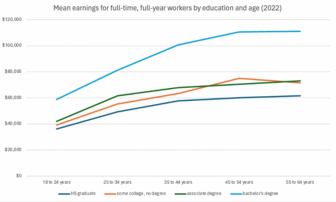2017 per capita income data for states has been published. What the data make clear for Michigan is that we are now structurally a low-prosperity state. No matter ![]() whether the state’s and the nation’s economy is growing or declining
whether the state’s and the nation’s economy is growing or declining
Michigan’s per capita income––in a strong economy with an even stronger domestic auto industry––is 11 percent below the national average. In 2000––the last time Michigan had a strong economy and domestic auto industry––Michigan’s per capita income was one percent below. Maybe most concerning is that the portion of per capita income that comes from wages and employer-paid benefits is now 12 percent below the national average. In 2000 it was one percent above.
Michigan’s per capita income is now more than $3,000 below the nation’s. Its employment earnings per capita is nearly $4,000 below the nation’s
How does Michigan compare to Minnesota–the Great Lakes state with the best economic outcomes? Minnesota’s per capita income in 2017 is five percent above the national average. Employment earnings per capita are nine percent above. The difference is more than $8,000 in per capita income between Michigan and Minnesota, with more than $6,500 of the difference coming from employment earnings per capita.
(You can explore what Minnesota has done to become so successful here. And the metro Minneapolis success recipe here.)
Since our inception more than a quarter of a century ago we have used per capita income as our prime measure of economic well being. It is the most comprehensive measure of income calculated by the statistical agencies of the federal government. It includes more sources of income than that used to calculate median household income for instance. Over the past decade or so we have concentrated more and more on the portion of per capita income that comes from employment earnings (wages, self-employment net earnings and employer paid benefits). The other two major categories of per capita income are government transfer payments and interest, dividends and rent (but not capital gains). Employment earnings represent 63 percent of the nation’s per capita income and for Michigan it is 62 percent.
Employment earnings combine both how many people work and how much they earn in wages and benefits. To us rising employment earnings are the key to our goal of recreating a high-prosperity Michigan. A place with a broad middle class.
That Michigan is now––in a strong economy––12 percent below the national average in employment earnings per capita is evidence that too many Michigan families unable to pay the bills, save for their retirement and the kids education is the preeminent economic challenge of our time. Michigan has both too many adults not working and way too many Michigan workers in low-paid and low-benefit jobs. We need to make dealing with both the state’s economic priorities.







